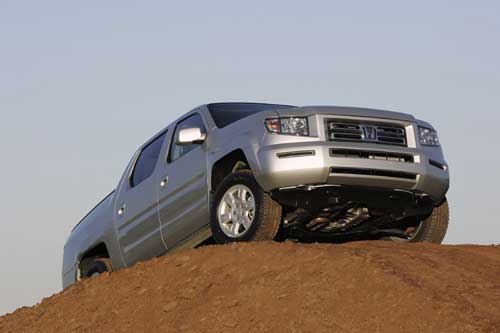Recent Articles
Popular Makes
Body Types
2006 Honda Ridgeline Road Test
A terrific truck, but a lousy truck-truck
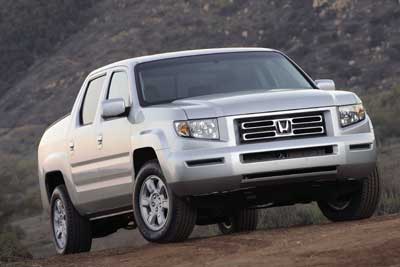
TO THE POINT What’s New? Honda redefines what a pickup truck can be with the all-new 2006 Ridgeline. Selling Points: Standard all-wheel drive; roomy cab for five adults; roomy trunk under cargo bed; dual-action tailgate Deal Breakers: Uncomfortable front seats; no expandable cargo bed; can’t tackle difficult off-road terrain; low towing capacity Our Advice: The 2006 Honda Ridgeline is the perfect daily driver for weekend do-it-yourselfers with lighter loads to tow. Commercial truck buyers, people with heavy payload and towing requirements, folks who need serious off-roading capability, and men overcompensating for something will still choose a Chevy, Dodge, Ford, GMC, or Nissan. Most personal-use truck buyers spend their time driving alone, on dry pavement, with nothing in the bed or hanging off the trailer hitch. So it should come as no surprise that wily Honda has targeted exactly that user with its first pickup truck ever, the 2006 Ridgeline. Now, the Ridgeline has taken plenty of knocks from traditional pickup truck drivers. They claim that it can’t compete without a V8 engine, lacks true off-roading capability, and can’t tow or haul enough weight. If you’re buying a truck for towing or for serious off-roading, well, Honda cannot help you, that much is true. But the 2006 Honda Ridgeline absolutely excels at single-occupant commutes, possesses best-in-class handling on pavement, and can easily take a family of four to the beach, or the mountains, or the local Home Depot on the weekends. And in a pinch, it can tug or tote more weight than most people need. That’s why the Ridgeline is our Autobytel Editors’ Choice for 2006 Truck of the Year, and why it has also won accolades from other publications and the North American Truck of the Year panel of jurists. The 2006 Honda Ridgeline is offered in RT, RTS, and RTL trim level, starting at $28,250 (all prices listed here include a $550 destination charge). The Ridgeline RT comes with the standard – and only – 247-hp V6 engine, VTM-4 all-wheel drive, stability and traction control, four-wheel-disc antilock brakes with EBD and brake assist, and both side-impact and side-curtain airbags. Additionally, the RT is equipped with everything most folks want, like air conditioning, a tilt steering wheel, power windows (including the rear slider), power door locks, cruise control, and keyless entry. Also part of the base price is a heated wiper-rest zone, a 100-watt audio system with a CD player, all-weather floor mats, cargo bed lighting, a manual driver’s seat height adjuster, and steel wheels. Step up to the $30,625 Ridgeline RTS to enjoy alloy wheels, a power driver’s seat, a more powerful 160-watt audio system with an in-dash six-disc CD changer, dual-zone automatic climate control, and an outside temperature gauge. The $31,490 Ridgeline RTL gets leather seat upholstery, a HomeLink programmable transmitter, a compass, and heated front seats. The RTL trim level is also your ticket to options like a power sunroof, XM satellite radio, and a navigation system with voice recognition. Standard on models with navigation is an auxiliary input jack for your iPod so you can listen to your music library through the Ridgeline’s speakers. A loaded Ridgeline RTL runs $35,190, and if you’ve still got money in your pocket your dealer can install roof rails and, on the RTL, an on-board DVD entertainment system for the rear seat. We test drove two different 2006 Honda Ridgeline RTLs with the optional navigation system. The first truck was an early-build unit, and was driven around the Los Angeles area by our staff, including an off-roading trip to the Wildomar Off-Highway Vehicle Park near Lake Elsinore. The other test truck was used for cruising around in the Chicago area by your author, covering pockmarked city streets, suburban neighborhoods, and rural two-lane roads. Aside from my vociferous complaints about long-distance seat comfort, some build quality issues with the California test truck that the whole crew noted, the lack of an expandable cargo bed, and a fussy navigation system, we found very little to complain about with the 2006 Honda Ridgeline. But, as pick-em-up purists would tell you, that’s because we ain’t haulin’ or towin’ nothin’ up to a backwoods deer camp in a November blizzard. For that, we’d need a V8, a low-range transfer case, and – because the fellas at deer camp can get mighty lonesome at the onset of winter – a few bottles of stiff whiskey and a bootleg copy of “Brokeback Mountain.”
Performance
Key Points: • 3.5-liter V6 with five-speed automatic • 247 hp. at 5,750 rpm; 245 lb.-ft. torque at 4,500 rpm • EPA says 16 mpg city and 21 mpg highway • Standard Variable Torque Management all-wheel-drive system • Tows 5,000 pounds; Hauls 1,554-lb. total payload Despite its 3.5-liter, 247-horsepower V6 engine and a curb weight just shy of 4,500 pounds, the 2006 Honda Ridgeline offers decent punch off the line and good response for passing on the highway. Only when loaded down with passengers and/or gear does the truck begin to feel sluggish, and yes, on hills with hundreds of pounds of payload the Ridgeline quickly spends its head of steam. But for the majority of the light-duty tasks it is asked to perform, the V6 is powerful enough, and it features a pleasantly sporty exhaust note when it’s all revved up. Just in case you need to hook 5,000 pounds of trailer up to the Ridgeline’s rump, it comes standard with pre-wiring for a 4- and 7-pin connection, an automatic transmission cooler, an oil cooler, a power steering cooler, dual radiator fans, and a special air intake system for better performance in hot weather. There’s no tow mode for the transmission, but the automatic kicks down with verve for passing and operates unobtrusively otherwise, though, as with Honda automatics in the Civic and Odyssey, we had trouble finding “drive” and “reverse” due to vague detents between gears. Our California test truck averaged 16.3 mpg in mixed driving, just more than the EPA city rating of 16 and nowhere near the EPA highway rating of 21, but that’s still better than most 4WD pickups in the compact and full-size segments. Our trip to the desert near California’s Lake Elsinore proved that the 2006 Honda Ridgeline is no rock-hopper. Its all-wheel-drive system is called VTM-4 (Variable Torque Management), and it automatically adjusts power delivery depending on traction conditions, sending as much as 70 percent of the engine torque to the rear wheels as necessary. When four-wheeling, a “lock” mode ensures a 50/50 power split for maximum traction, but it only works when the Ridgeline’s automatic is placed in the lowest possible gear. Thanks to a lack of low-range gearing, meager approach, breakover, and departure angles, and a modest 8.2-inch ground clearance, we could traverse only the easy and a few medium difficulty trails at the Wildomar Off-Highway Vehicle Park. However, we should point out that the Ridgeline managed to complete one somewhat difficult section, which could make your average Jeep Grand Cherokee owner squeamish, with only a little scraping and wheelspin.
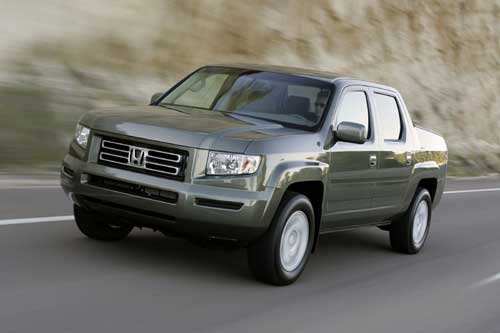
Handling
Key Points: • Independent front and rear suspension • Four-wheel disc antilock brakes with EBD and Brake Assist • Standard stability and traction control system • P245/65R17 Michelin LTX M/S tires • Variable-assist rack-and-pinion steering with heavy-duty cooler Pop quiz: What pickup, other than the 2006 Honda Ridgeline, comes with a four-wheel independent suspension for superior on-road handling and ride quality? If you answered “none,” you’re right. What a difference the Ridgeline’s front MacPherson struts and rear multi-link arrangement with trailing arms makes. One of the best things about the Ridgeline is the way it rides around town without bucking and kicking, the way it tackles a corner without squealing and shuddering, the way the weight transfers so predictably in S-curves when you’re hustling along faster than a pickup truck should. In fact, so stable is the Honda Ridgeline that the NHTSA says it has the best rollover resistance rating of any pickup on the market. Anyone who has forsaken responsiveness and smoothness for the ability to tow a load of jet skis or snowmobiles a few times a year with a competing “traditional” pickup will find the Ridgeline a revelation. And then they will find the title to their old truck and trade it in for a Ridgeline right quick. But it’s not just the Ridgeline’s suspension that results in surprisingly nimble handling. The four-wheel-disc brakes, vented up front, are connected to a brake pedal that provides excellent feel and progressive response, letting the driver fine-tune the pressure that the calipers put on the pads. Standard ABS and electronic brake-force distribution assist in this regard, and if you’re involved in a panic stop, the brake assist system can apply full pressure faster than your foot can. Variable-assist power rack-and-pinion steering offers crisp response and the P245/65R17 Michelin LTX mud-and-snow tires provide good grip both on and off the road. Pitch the 2006 Honda Ridgeline into a fast, sweeping, constant-radius curve, however, and you’ll feel an odd tugging at the helm, like the power assist is cycling on and off. But then you remember that the Ridgeline is a pickup truck, and this trait is easy to forgive. You’ll also cheer when running the Ridgeline around town. It’s more maneuverable than expected thanks to clear sightlines, large side mirrors, a relatively tight 42.6-foot turning radius, and an alloy wheel design that doesn’t stick out past the tire sidewall to catch curbs. Plus, the Ridgeline’s corners are very easy to judge for parking. Usually, we find pickup trucks fun to drive because they are raucous and unrefined, and there’s something authentic – and challenging – about that experience. The 2006 Honda Ridgeline is lots fun to drive, too, but in the communicative manner of a sports sedan rather than the roughneck ways of regular pickups. And for a truck, that’s amazing.
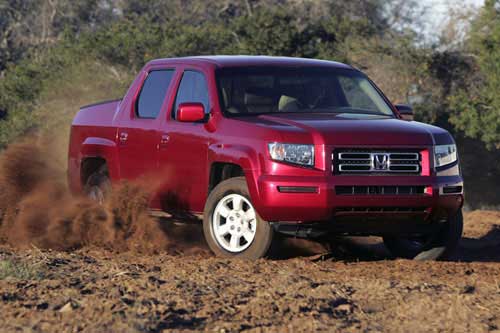
Interior Comfort
Key Points: • Five-passenger seating capacity • Leather is standard on Ridgeline RTL • 40.8 inches of front leg room • 36.4 inches of rear leg room • Front seats feel hard after a few hours Nobody else but me complained about the Ridgeline’s front seat comfort. It should be noted, however, that nobody else but me spent six continuous hours in the saddle, and after that quarter of a day had passed, I couldn’t wait to get out of the thing. The front seats are wide and flat, designed to accommodate big American bodies, and my Ridgeline RTL had eight-way power adjustment that allowed me to find a perfect driving position with terrific thigh support. At first the driver’s seat felt firm and supportive, and anyone taking a test drive in the Ridgeline is likely to feel the same way. But after an extended period of time, it felt like it was filled with concrete. Two other issues only served to exacerbate my discomfort. The upper door panel, where I usually rest my elbow, was trimmed in hard plastic, and the leather-wrapped steering wheel was uncomfortably shaped, making it displeasing to hold after awhile. Additionally, I felt that Honda could stand to increase the front leg room for my 33-inch inseams, but that’s a minor point compared to the seats, door panel, and steering wheel. I won’t even detail the pain I endured when I smacked my right shin into the hard plastic lower dash getting into the truck one day. Jumping into the back seat proved that I’d just rather not sit in the Ridgeline at all, so I grabbed the nifty handle mounted to the B-pillar and hoisted myself out. The backrest angle is perfect, the full head restraints help to keep occupants’ noggins from slamming into the rear glass during a hard hit to the back, and there was plenty of foot room for my size-12 Timberlands under the front chairs. But like the front cushions, the rear bench was hard and flat, and mounted too low to the floor for my taste. Additionally, my knees and shins were brushing the hard plastic front seatbacks. So while it possible to haul three of your best buds into the woods for a little fishing, they’re not going to be crossing their legs in limo-like comfort along the way. At least the rear air conditioning and heating vents, a big center armrest, four cupholders, the optional DVD entertainment system, and the reasonably quiet interior at highway speeds should keep them from noticing any lack of leg room.
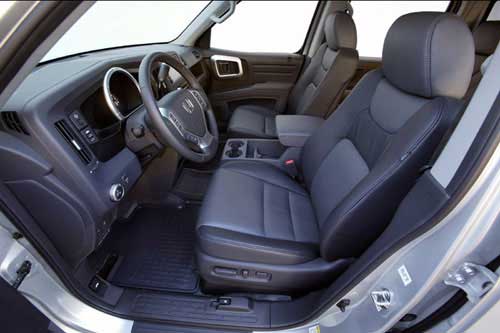
Interior Design
Key Points: • Dual-stage front airbags • Side-impact and side-curtain airbags • Lots of storage with rubber liners for easy cleaning • No pass-through to increase cargo bed length like Chevy Avalanche Purposeful, utilitarian, strange – these are the adjectives conjured by the 2006 Honda Ridgeline’s cabin. Thankfully, the design works. What could be a mind-numbing amount of medium gray plastic is nicely complemented by light gray pillar trim and a woven cloth headliner. Silver plastic accents add a touch of visual interest, and the Ridgeline RTL’s leather seating is decorated in two-tone trim for a more upscale appearance. At the floor, heavy-duty all-weather rubber floor mats speak to the Ridgeline’s mission in life. The end result is an interior that is industrial in design yet tasteful in style. Honda’s got safety covered, too. Dual-stage front airbags with a passenger’s side occupant detection sensor are standard, along with front side-impact airbags. Outboard seating positions benefit from side-curtain airbags that include rollover sensors to remain inflated for an extended period of time if the Ridgeline flips. Also, three-point seatbelts and head restraints are located in all five positions. The result is a five-star rating in each of the NHTSA’s frontal- and side-impact crash tests. One of the 2006 Honda Ridgeline’s critical flaws, however, is the lack of a pass-through to the cargo bed like the Chevrolet Avalanche has. Sure, there’s a power sliding rear window through which you can slide eight-foot pieces of lumber that will poke and tear and rip your truck’s headliner, but who needs that hassle? Over at Chevy, you can buy a truck that opens the whole rear of the cab to the bed, creating a large enough opening to carry more than just lumber. Even the unloved Subaru Baja’s bottom half can accommodate long flat items through a small but wide pass-through. In our opinion, Honda missed the boat on this useful feature.
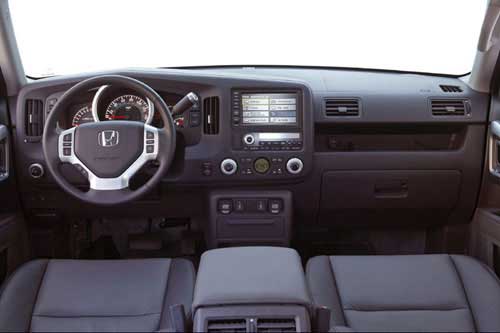
Control Layout
Key Points: • No stereo tuning knob • Small stereo buttons won’t work well with work gloves • Climate controls are perfection • Navigation voice recognition and programming needs improvement • Fuel release on the floor where it could fill with grime In designing the 2006 Honda Ridgeline’s stereo, the ergonomics experts must have assumed that most owners’ fingers would be more familiar with Caress than Carhartts, because it would be darn near impossible to operate anything except the volume while wearing work gloves. And if you’ve got a Ridgeline RTL with navigation, you’ve gotta power the display screen out of the way to access the in-dash six-disc CD changer. At the very least, Honda could have provided a nice, big tuning knob to go along with the nice, big volume knob. By contrast, the dual-zone climate controls are a model of perfection, featuring large, logically-clustered, well-marked buttons flanked by gigantic temperature knobs. The Ridgeline’s remaining controls are funky, mainly because they’re placed where you don’t expect to find them. For instance, the button that activates the cruise control is way down low on the lower left dash panel right next to the stability control “kill” button and the parking brake release. This is a ridiculous spot to locate a feature used so frequently – especially since all other cruise functions are placed front-and-center on the steering wheel. We also noticed that the fuel release lever is on the floor where it most likely will fill with the same grit, grime, mud, and snow that the super-duper floor mats are charged with trapping. Finally, the fuel gauge has no arrow pointing to the side of the truck where filler neck is located, but that’s more a problem for people like us who drive a Ridgeline for a week and then move on to the next set of wheels. Since our Ridgeline RTL test trucks came with voice-control navigation systems, we gave ‘em a whirl and found the voice commands not terribly helpful. For example, we couldn’t get our California test truck to recognize “Irvine” as a city when programming a destination or “Korean” for restaurants – and we weren’t so juvenile as to try a fake Russian accent while making the commands. Moving on to manual programming, we found that the system’s small buttons and sensitive joystick toggle resulted in many errors, so it would be nice to have a “Back” button on the dash (there’s one on the steering wheel, which is extra work when your hand is flitting about on the dashboard). The last method for programming is the touch screen, but the QWERTY display is a bad idea since you’re not sitting at your cubicle typing a nasty-gram to the accounts payable department. A simpler ABCDEFG layout would be better. Honda does include useful features with the navigation system. Handy buttons to zoom the map display and to cancel navigation instructions are sitting right there on the dash – no need to cycle through menus looking for these features. There’s also a slick scheduling calendar, a calculator, Zagat restaurant ratings, and a voice command “help desk.” Just don’t ask about Korean cuisine or Irvine, Calif., and you should be fine.
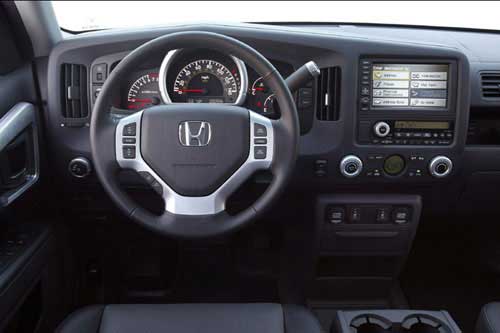
Storage and Cargo
Key Points: • Locking In-Bed Trunk holds 72-quart cooler • Dual-action tailgate flips down or open to side • 41.4 cu-ft. of interior cargo space with rear seat folded • 1,100-pound bed payload capacity • Six heavy-duty tie-down cleats Excuse Honda for missing an excellent opportunity to improve upon Chevy’s Avalanche design by offering a mid-gate system that could expand the length of the cargo bed, and you’ll find that it is in the areas of storage and cargo that the 2006 Ridgeline excels. The interior is littered with storage trays, bins, and cubbies; all large, and most lined with a rubber mat for easy cleaning and to grip smaller objects and keep them in place. We particularly liked the exposed in-dash cubbies located in the passenger’s side of the dashboard, an area usually dedicated to thick-grained plastic or fake wood trim in other trucks. The Ridgeline’s glovebox is positively huge, and the giant center bin has a private storage box at the bottom. Even the door handles have integrated trays. Occupants enjoy two big cupholders in front, and four in the back. Outside, the Honda Ridgeline’s steel-reinforced composite (SRC) cargo bed measures five feet long, and though you can carry longer items by poking them through the sliding rear window or driving with the tailgate dropped, neither solution is preferable to a GM-style mid-gate design that would extend the bed into the cabin. In case you’re wondering, the bed is 20.7 inches deep, 49.5 inches wide at the wheel wells, and can carry up to 1,100 pounds. It even has indents molded into the SRC to accommodate motorcycle wheels. Under the bed is Honda’s ingenious, and class-exclusive, locking trunk. The trunk is bigger than you might think, able to hold a 72-quart cooler, three golf bags, or, if Tony Soprano is creative enough, a former “associate.” Use it as a “cooler” and you can drain fluids through the special plug at the bottom. Plus, four in-bed lights make loading and unloading in the dark a snap. Accessing the cargo bed using the dual-action tailgate is easy. You can drop the tailgate like a conventional truck for tailgate parties, loading heavy items, or carrying longer cargo. Or, you can swing the tailgate to the side to make use of the in-bed trunk. If you need to protect your gear from the elements, you can stow up to 2.6 cubic feet of stuff underneath the standard 60/40-split folding rear seat. That’s not much, granted, so kick your passengers to the curb and pile as much as 41.4 cu.-ft. of stuff on top of the folded rear seat. Or, you can flip the back bottom cushion up with one-hand and slide a mountain bike inside. Honda even installed a plastic groove in the floor perfect for holding the tires.
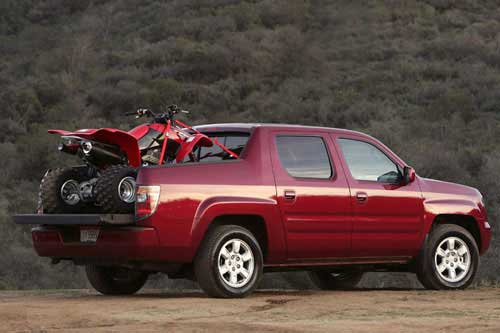
Exterior Design
Key Points: • Closed-box unibody construction is unique in segment • Structural rigidity is 20X traditional pickups • Tonka-meets-Transformer exterior styling Industrial and architectural in theme, the 2006 Honda Ridgeline’s head-turning styling is definitely odd, and from various angles with changing daylight you can see subtle design cues that are not always evident – or appealing. Given the bold and intriguing look, the standard steel wheels and optional alloys are rather tame in terms of appearance, making the Ridgeline a prime candidate for a visit to the wheel-and-tire store. Also, we’re not fans of the way the tailgate is shorter than the sides of the cargo bed, as if the two teams that engineered these parts suffered an utter failure to communicate. On a positive note, at least the Ridgeline isn’t boring. Structurally, Honda says the Ridgeline boasts 20 times the rigidity of a traditional body-on-frame pickup thanks to its unique “closed-box” unibody construction. Engineered to offer the load-carrying benefits of a ladder frame and the rigidity of a monocoque design, the 2006 Honda Ridgeline is built upon two fully-boxed longitudinal frame rails fortified by seven high-strength steel cross members in a unitized body. Of course, since Honda doesn’t have a rear-drive platform in-house, and since the Ridgeline would have become prohibitively expensive if Honda had built a traditional truck from scratch, it had no choice other than to create this hybrid foundation, which ii calls a “closed box” unibody design. According to the PR folks, the spin is that it’s unique in its segment.
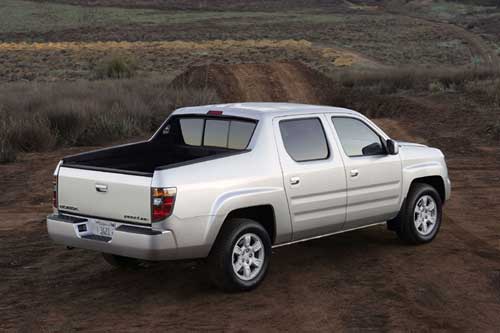
Quality
Key Points: • Lots of hard plastic throughout interior • Soft yet durable leather in the RTL model • Industrial-strength floor mats • Precise control operation • Some rattles and squeaks Like any pickup truck on the market today, the 2006 Honda Ridgeline has a fair amount of hard plastic throughout the interior. The good news is that it’s not terribly glossy, but the bad news is that there are squeaks and creaks on rough pavement. To offset this, the Ridgeline benefits from high-quality touches such as switchgear that looks and feels great, operating with the well-damped precision of a luxury sedan. The standard all-weather floor mats are substantial and mean business, and the woven mesh headliner wouldn’t look out of place inside an Audi. As for build quality, our California test vehicle was an early-build production unit with some hard miles on it, and it was not up to Honda standards. Our Chicago test vehicle was much improved, but still held a few rattles and squeaks. The truck we drove in L.A. suffered a squeaky dash, misaligned airbag covers in front, right A-pillar trim that had an obvious gap between it and the dash, inconsistent glove box door gaps, warped lower left dash plastic, and slightly crooked navigation system installation. Outside we found a front fascia that would embarrass General Motors in terms of fit, GM-sized tailgate gaps, bad rubber seal fits on the driver’s door, and cheap plastic bumper “pads” that could be clipped in and out with our bare hands. If not for a follow-up drive in a different Ridgeline, we’d have trouble asserting confidence in what you’ll find on a dealer lot today, but the truck we had in Chicago was screwed together with much more care.
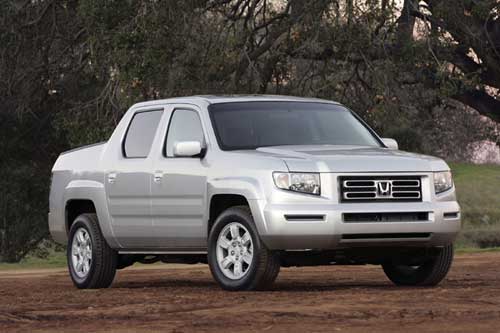
Specifications
Key Points: • Chevrolet Colorado • Dodge Dakota • Ford Explorer Sport Trac • Nissan Frontier • Toyota Tacoma Test Vehicle: 2006 Honda Ridgeline RTL with Navigation Price of Test Vehicle: $35,190 (including $550 destination charge) Engine Size and Type: 3.5-liter V6 Engine Horsepower: 247 at 5,750 rpm Engine Torque: 245 lb.-ft. at 4,500 rpm Transmission: Five-speed automatic Curb weight, lbs.: 4,498 EPA Fuel Economy (city/highway): 16/21 Observed Fuel Economy: 16.3 mpg Length: 206.8 inches Width: 76.3 inches Wheelbase: 122.0 inches Height: 71.2 inches (with RTL’s sunroof) Leg room (front/rear): 40.8/36.4 inches Head room (front/rear): 38.7/39.0 inches (with RTL’s sunroof) Max. Seating Capacity: Five Max. Cargo Volume: 39.5 cu.-ft. (behind front seats with rear seat folded) Max. Payload: 1,554 pounds Max. Towing Capacity: 5,000 pounds Max. Ground Clearance: 8.2 inches Competitors: Chevrolet Avalanche, Chevrolet Colorado, Dodge Dakota, Ford Explorer Sport Trac, GMC Canyon, Isuzu i350, Mitsubishi Raider, Nissan Frontier, Subaru Baja, Toyota Tacoma
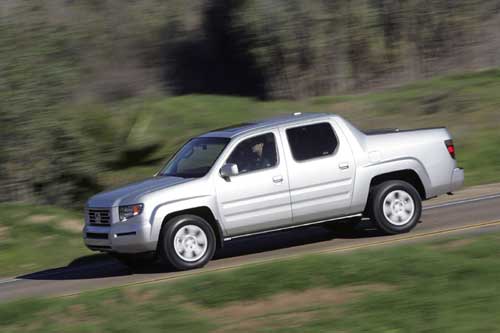
Second Opinion – Perry
Key Points: • Nice truck, even for guys who don’t like trucks • Impressive performance, handling, and ride quality • Could use a V8 engine • Styling lacks originality • Perfect for weekend warrior homeowners Not really being a truck guy (although I own one out of necessity), I wasn’t really expecting a whole lot from the new 2006 Honda Ridgeline. After all, it’s the company’s first attempt at creating a pickup truck. I must admit, though, that the Ridgeline pleasantly surprised me. The first thing I noticed upon entering the cab was a car-like feel of luxury. Unlike many other trucks in this class, the Ridgeline’s interior doesn’t have a cheap plastic feel. Controls are well placed and easy to use, and there’s plenty of room and comfort for front and rear passengers. On the first leg of my drive I opted for a twisty local highway. To my surprise, the 2006 Honda Ridgeline performed exceptionally well in terms of both performance and handling. Power always seemed to be available when calling upon the V6 engine and navigating corners was surprisingly easy with minimal understeer. Despite its taut handling character, the Ridgeline also produced a smooth ride. Though the 247-horsepower V6 engine was impressively proficient during my drive and is more than adequate for those trips to Home Depot, I doubt that the Ridgeline will be taken seriously by real truck buyers until a V8 motor makes its way under the hood. Honda has taken steps to try and attract tough-truck buyers though, by offering as standard equipment a high capacity radiator with dual 160-watt fans, power steering and automatic transmission coolers, and a 5,000-lb. towing capacity. I guess the real question here is: Which market is Honda hoping to attract, the serious truck buyer or the do-it-yourself homeowner who desires the utility of a truck with car-like creature comforts? My biggest disappointment with the 2006 Honda Ridgeline is its lack of distinctive styling. At first glance it could be mistaken for a next-generation Chevy Avalanche. Though the lines are cleaner than the plastic add-on looks of the Avalanche, the Ridgeline lacks the rugged look necessary to set it apart from its competitors. With other manufacturers putting such an emphasis on original design, I have to wonder why Honda took the old road of borrowing from an existing design and putting their own twist on it. Originality goes a long way in my book. Nevertheless, the 2006 Ridgeline is a very good first attempt at a truck for Honda. With its comfort, handling and performance the Ridgeline is a great vehicle for the homeowner that occasionally finds the need for a truck but wants to retain the refinement and comfort of a luxury car. –
